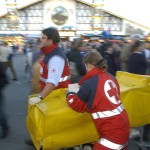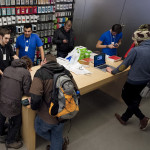Oktoberfest 2013 Begins Two Weeks of Food, Beer, and Fun
The final preparations are underway as the city of Munich gets set to welcome more than 6 million visitors for its 180th annual Oktoberfest. The event’s location, the Theresienwiese, known as Wiesn by your Munich hosts, has been transformed from a 100-acre cement field into a vast party zone, featuring 34 beer tents, rides, game booths, and food stands. With a mass of Lederhosen and Dirndl-clad party-goers descending on Munich, the normally staid and settled Bavarian culture will reveal its Dionysian side, with 16 days of food, drink, music, and revelry.
At 12:00 Saturday, September 21st at the Schottenhamel tent, Munich’s long-serving mayor, Christian Ude, will utter the famous Bavarian phrase, “O’zapft is”, meaning “It is tapped!”, thus launching the largest folk festival in the world. More than 7 million liters of beer, half a million chickens, and tens of thousands of grilled pork knuckles will be served to revelers strolling through the fair grounds or enjoying the gemütlich (jovial) atmosphere of the beer tents, which are served by any of the six Munich breweries, whose beer meets the Oktoberfest standard by being brewed in Munich according to the well-known German purity law, the Reinheitsgebot.
The festival finds its origins in the wedding of King Ludwig I and Therese of Saxe-Hildburghausen on October 17, 1810, when the people of Munich celebrated on the fields outside of the city gates. The last day of the festivities featured a horse race, which then became an annual event, leading to the modern day festival beginning in September. Except for cancellations due to war and disease, it has
taken place regularly over its more than-200 year history and become an institution of Munich culture.
The six major breweries, Augustiner, Paulaner, Spaten, Hacker-Pschorr, Löwenbräu, and Hofbräu, host a total of 14 large tents, each with its own tradition and prices, and each catering to a different set, from the exclusive Käfer’s Wies’n Schänke to the popular Hacker Festzelt. On top of that there are 20 smaller tents with a range of themes. The music played at each tent depends on the time of day. In an effort to keep the festival true to its roots—and to keep it quiet during the day for older visitors and families—the tents play quiet, most often traditional, music before 6:00pm, but into the night, bands amp it up a bit and play international hits and German Schlagermusik.
The fame it enjoys outside of Germany draws visitors from around the world, including Italians, British, Australians and Americans—a huge economic boon for the city—but it is the locals that still make up the largest portion of the attendees, with more than 70% of the crowd coming from Bavaria. With its great size and open, convivial atmosphere, Oktoberfest attracts visitors from all walks of life and all age groups, featuring two official family days as well as the unofficial “Gay Day” and “Italian Weekend”. From the opening parade through Munich to the
traditional brass-band concert held under the giant statue of Bavaria midway through to the gun salute signaling the end of the festival, this year’s Oktoberfest will again show off the Bavarian way to play.






 Euro Converter
Euro Converter